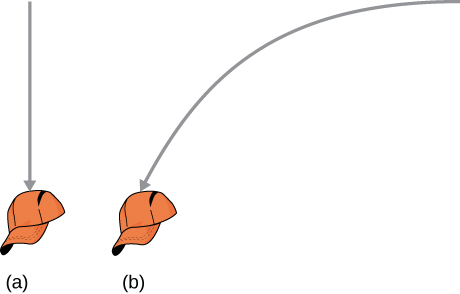| << Chapter < Page | Chapter >> Page > |
What frame or frames of reference do you use instinctively when driving a car? When flying in a commercial jet?
A basketball player dribbling down the court usually keeps his eyes fixed on the players around him. He is moving fast. Why doesn’t he need to keep his eyes on the ball?
If he is going to pass the ball to another player, he needs to keep his eyes on the reference frame in which the other players on the team are located.
If someone is riding in the back of a pickup truck and throws a softball straight backward, is it possible for the ball to fall straight down as viewed by a person standing at the side of the road? Under what condition would this occur? How would the motion of the ball appear to the person who threw it?
The hat of a jogger running at constant velocity falls off the back of his head. Draw a sketch showing the path of the hat in the jogger’s frame of reference. Draw its path as viewed by a stationary observer. Neglect air resistance.

A clod of dirt falls from the bed of a moving truck. It strikes the ground directly below the end of the truck. (a) What is the direction of its velocity relative to the truck just before it hits? (b) Is this the same as the direction of its velocity relative to ground just before it hits? Explain your answers.
The coordinate axes of the reference frame remain parallel to those of S , as moves away from S at a constant velocity (a) If at time t = 0 the origins coincide, what is the position of the origin in the S frame as a function of time? (b) How is particle position for and as measured in S and respectively, related? (c) What is the relationship between particle velocities (d) How are accelerations related?
a.
,
b.
,
c.
, d. The accelerations are the same.
The coordinate axes of the reference frame remain parallel to those of S , as moves away from S at a constant velocity . (a) If at time t = 0 the origins coincide, what is the position of origin in the S frame as a function of time? (b) How is particle position for and , as measured in S and respectively, related? (c) What is the relationship between particle velocities (d) How are accelerations related?
The velocity of a particle in reference frame A is The velocity of reference frame A with respect to reference frame B is and the velocity of reference frame B with respect to C is What is the velocity of the particle in reference frame C ?
Raindrops fall vertically at 4.5 m/s relative to the earth. What does an observer in a car moving at 22.0 m/s in a straight line measure as the velocity of the raindrops?
A seagull can fly at a velocity of 9.00 m/s in still air. (a) If it takes the bird 20.0 min to travel 6.00 km straight into an oncoming wind, what is the velocity of the wind? (b) If the bird turns around and flies with the wind, how long will it take the bird to return 6.00 km?
a. A = air, S = seagull, G = ground
velocity of seagull with respect to still air
b.

Notification Switch
Would you like to follow the 'University physics volume 1' conversation and receive update notifications?